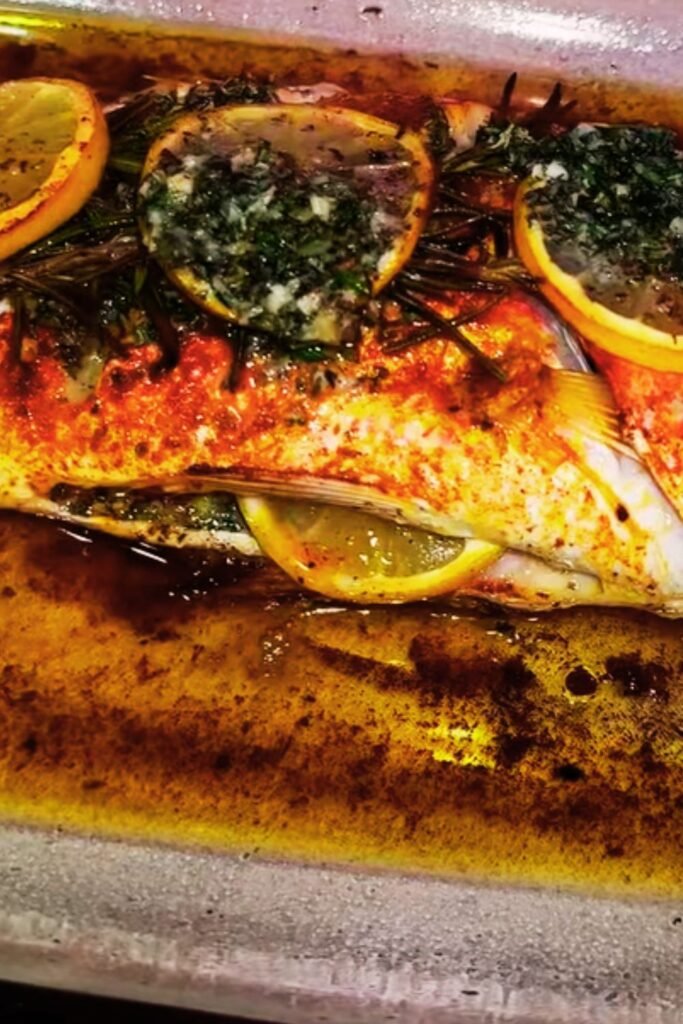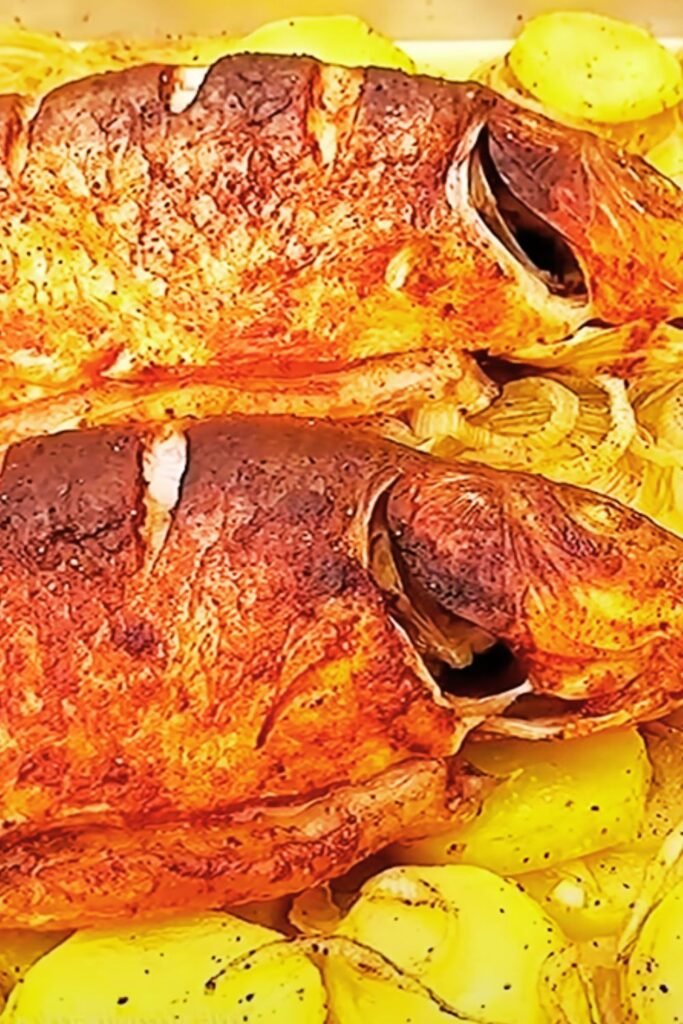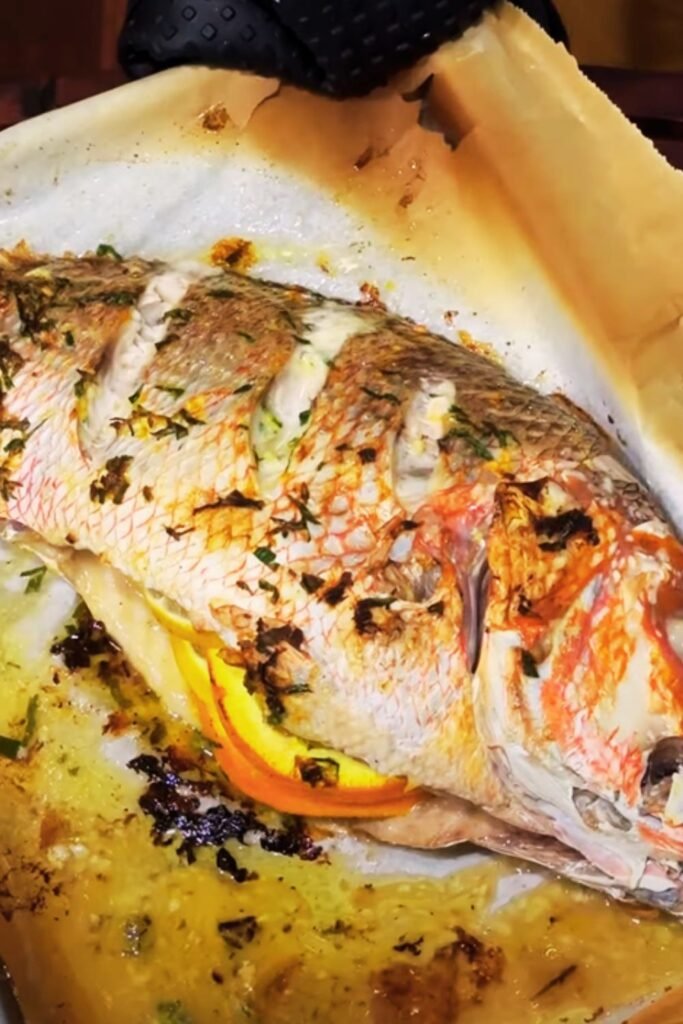When I first attempted to cook a whole yellowtail snapper, I’ll admit I was intimidated. The beautiful fish stared back at me from the cutting board, and I wondered if I’d bite off more than I could chew. However, after years of perfecting this technique, I can confidently say that baking a whole yellowtail snapper is one of the most rewarding and surprisingly simple ways to prepare fish. The result is a stunning centerpiece dish that delivers incredible flavor with minimal effort.
Yellowtail snapper ranks among my favorite fish to prepare because of its delicate, sweet flavor and firm texture that holds up beautifully during baking. Unlike some fish that can become dry or fall apart easily, yellowtail snapper maintains its moisture and flakes perfectly when cooked properly. This recipe transforms a simple fish into an elegant meal that will impress family and guests alike.
Understanding Yellowtail Snapper
Yellowtail Snapper (Ocyurus chrysurus) : A tropical marine fish found primarily in the western Atlantic Ocean, characterized by its bright yellow tail fin and streamlined body.
Flavor Profile : Mild, sweet taste with a slightly nutty undertone and firm, white flesh that flakes easily when cooked.
Nutritional Benefits : High in protein, omega-3 fatty acids, vitamin B12, and selenium while being low in saturated fat and calories.
Seasonality : Available year-round, with peak season typically from late spring through early fall.
Size Range : Whole yellowtail snappers typically range from 1-3 pounds, with 1.5-2 pound fish being ideal for this recipe.
The beauty of cooking yellowtail snapper whole lies in how the bones and skin protect the delicate flesh during the cooking process. This natural barrier helps retain moisture while infusing the meat with deeper flavors from the seasonings and aromatics.
Essential Ingredients and Selection
Selecting the right fish makes all the difference in this recipe. When I shop for yellowtail snapper, I look for several key indicators of freshness. The eyes should be clear and bright, not cloudy or sunken. The gills should appear bright red or pink, and the skin should have a natural shine with scales that adhere firmly to the body.

Primary Ingredients
| Ingredient | Quantity | Purpose | Substitution Options |
|---|---|---|---|
| Whole Yellowtail Snapper | 1 (1.5-2 lbs) | Main protein | Red snapper, sea bass, or branzino |
| Olive Oil | 3 tablespoons | Moisture and browning | Avocado oil or melted butter |
| Fresh Lemon | 2 large lemons | Acidity and brightness | Lime or orange |
| Garlic | 4 cloves | Aromatic base | Garlic powder (1 tsp) |
| Fresh Herbs | 2 tablespoons each | Flavor enhancement | Dried herbs (1 tsp each) |
| Sea Salt | 1 tablespoon | Seasoning | Kosher salt |
| Black Pepper | 1 teaspoon | Heat and depth | White pepper |
| Paprika | 1 teaspoon | Color and mild heat | Smoked paprika |
Supporting Ingredients
The supporting cast of ingredients elevates this dish from simple to spectacular. I prefer using fresh thyme and rosemary because their robust flavors complement the delicate fish without overwhelming it. The combination of lemon zest and juice provides the perfect acidic balance that brightens the entire dish.
For the vegetable accompaniment, I often include sliced onions, bell peppers, and cherry tomatoes. These vegetables not only add color and nutrition but also create a natural bed for the fish while absorbing all the wonderful flavors during baking.
Preparation Techniques
Proper preparation sets the foundation for success with this recipe. I always start by ensuring my fish is completely thawed if previously frozen, as this affects cooking time and texture significantly.
Fish Preparation Steps
The first step involves thoroughly cleaning the fish. Even though most fish markets will clean the yellowtail snapper for you, I always give it a final rinse under cold running water. I pay special attention to the cavity, ensuring no blood or debris remains inside.
Next, I pat the fish completely dry with paper towels, both inside and out. This step is crucial because excess moisture prevents proper browning and can make the skin soggy rather than crispy.
Making diagonal cuts about 1/4 inch deep along both sides of the fish serves multiple purposes. These cuts allow the seasonings to penetrate deeper into the flesh while also helping the fish cook more evenly. I typically make 3-4 cuts on each side, spacing them about an inch apart.
Seasoning Strategy
My seasoning approach involves both internal and external applications. Inside the cavity, I place lemon slices, fresh herb sprigs, and minced garlic. This creates an aromatic steam chamber that infuses the fish from within.
For the external seasoning, I create a paste using olive oil, minced garlic, lemon zest, chopped herbs, salt, pepper, and paprika. This mixture gets rubbed all over the fish, making sure to work it into the diagonal cuts I made earlier.

The Perfect Oven Baking Method
Achieving the perfect oven-baked yellowtail snapper requires attention to temperature, timing, and technique. I’ve experimented with various temperatures over the years, and I’ve found that 425°F (220°C) provides the ideal balance of gentle cooking and proper browning.
Oven Setup and Equipment
| Equipment | Purpose | Alternative Options |
|---|---|---|
| Large rimmed baking sheet | Even heat distribution | Roasting pan or casserole dish |
| Parchment paper | Easy cleanup and prevents sticking | Aluminum foil (lightly oiled) |
| Instant-read thermometer | Accurate doneness testing | Visual cues and flake test |
| Kitchen timer | Precise timing | Phone timer or oven timer |
Preheating the oven to 425°F ensures the fish starts cooking immediately when placed inside, which helps develop that beautiful golden exterior while keeping the interior moist and tender.
Baking Process
I begin by lining my baking sheet with parchment paper, which makes cleanup effortless and prevents the fish from sticking. If using vegetables as a bed, I arrange them on the parchment first, then place the seasoned fish on top.
The initial baking time for a 1.5-2 pound yellowtail snapper is typically 25-30 minutes. However, I never rely solely on time because fish can vary significantly in thickness and density. Instead, I use the internal temperature as my primary guide.
The fish is perfectly done when the internal temperature reaches 145°F (63°C) at the thickest part. I insert my thermometer into the flesh behind the gills, being careful not to touch the bone which can give a false reading.
Visual and Textural Cues for Doneness
Beyond temperature, several visual and textural indicators help me determine when the fish is perfectly cooked. The skin should appear golden brown and slightly crispy. The flesh should be opaque throughout, with no translucent areas remaining.
When I gently press the thickest part of the fish, it should feel firm but still give slightly under pressure. Overcooked fish becomes rigid and dry, while undercooked fish feels soft and squishy.
The eyes of the fish will turn completely white when fully cooked, which serves as another reliable indicator. Additionally, the flesh should flake easily when tested with a fork at the thickest part.
Serving and Presentation
Presentation plays a crucial role in the dining experience, and a whole baked yellowtail snapper makes a stunning centerpiece. I always let the fish rest for 5-10 minutes after removing it from the oven. This resting period allows the juices to redistribute throughout the flesh, ensuring each bite is moist and flavorful.

Garnishing and Final Touches
Fresh herbs, lemon wedges, and a drizzle of good olive oil provide the perfect finishing touches. I like to sprinkle additional fresh herbs over the fish just before serving, as their bright color and fresh aroma create an appealing contrast to the golden-brown skin.
For special occasions, I sometimes add a light sprinkle of toasted pine nuts or a few capers for extra texture and flavor complexity.
Portion Guidelines
| Fish Weight | Number of Servings | Serving Style |
|---|---|---|
| 1-1.5 lbs | 2-3 people | Family style |
| 1.5-2 lbs | 3-4 people | Individual portions |
| 2-2.5 lbs | 4-5 people | Generous servings |
| 2.5-3 lbs | 5-6 people | Party presentation |
Complementary Side Dishes
The mild, sweet flavor of yellowtail snapper pairs beautifully with a wide variety of side dishes. I often serve it with roasted vegetables that have been cooked alongside the fish, absorbing all those wonderful flavors.
Rice pilaf or coconut rice provides a neutral base that complements the fish without competing with its delicate taste. For a lighter option, I might prepare a fresh salad with citrus vinaigrette or steamed asparagus with lemon butter.
Roasted potatoes seasoned with herbs make an excellent hearty accompaniment, while grilled vegetables add a smoky element that contrasts nicely with the clean flavors of the baked fish.
Storage and Leftover Ideas
Properly stored leftover yellowtail snapper will keep in the refrigerator for 2-3 days. I always remove the flesh from the bones before storing, as this makes reheating and using the leftovers much more convenient.
Cold leftover fish works wonderfully in salads, fish cakes, or tacos. I sometimes flake the leftover fish and mix it with mayonnaise, diced celery, and fresh herbs for a delicious fish salad that’s perfect for sandwiches or wraps.
For reheating, I prefer using the oven at a low temperature (300°F) rather than the microwave, which can make the fish rubbery. A light covering of foil helps retain moisture during reheating.
Troubleshooting Common Issues
Over the years, I’ve encountered and solved various challenges when baking whole yellowtail snapper. Understanding these potential issues helps ensure consistent success every time.
Dry Fish : Usually results from overcooking or not using enough oil/moisture during preparation.
Uneven Cooking : Often caused by fish that’s too thick or oven hot spots; rotating the pan halfway through cooking helps.
Sticking to Pan : Prevented by using parchment paper or ensuring the pan is properly oiled.
Fishy Smell : Indicates the fish wasn’t fresh; always buy from reputable sources and use within 24 hours.
Skin Not Crispy : Results from excess moisture on the fish surface or oven temperature too low.
Nutritional Benefits and Health Considerations
Yellowtail snapper offers exceptional nutritional value, making it an excellent choice for health-conscious diners. A 4-ounce serving provides approximately 140 calories, 26 grams of protein, and virtually no carbohydrates.
Nutritional Profile
| Nutrient | Per 4 oz Serving | % Daily Value |
|---|---|---|
| Calories | 140 | 7% |
| Protein | 26g | 52% |
| Fat | 3g | 5% |
| Omega-3 Fatty Acids | 0.3g | – |
| Vitamin B12 | 2.3mcg | 96% |
| Selenium | 42mcg | 76% |
| Phosphorus | 210mg | 30% |
| Niacin | 5.2mg | 32% |
The high protein content makes this dish excellent for muscle building and maintenance, while the omega-3 fatty acids support heart and brain health. The selenium content provides antioxidant benefits, and vitamin B12 supports nervous system function.
Seasonal Variations and Adaptations
I love adapting this recipe throughout the year based on seasonal availability of ingredients and personal preferences. During summer months, I might add fresh tomatoes, zucchini, and basil for a Mediterranean flair.
Fall adaptations might include roasted root vegetables like carrots, parsnips, and sweet potatoes as the bed for the fish. Winter versions could incorporate heartier herbs like sage and thyme, with perhaps some roasted Brussels sprouts or winter squash.
Spring calls for lighter touches – fresh peas, asparagus, and delicate herbs like dill or chervil complement the fish beautifully without overwhelming its subtle flavors.
Wine and Beverage Pairings
While I won’t suggest alcoholic beverages, there are many excellent non-alcoholic options that complement baked yellowtail snapper beautifully. Sparkling water with fresh lemon or lime provides a clean, refreshing contrast to the rich flavors of the fish.
Fresh fruit juices, particularly citrus-based ones, echo the lemon flavors in the dish while providing a bright, acidic counterpoint. Herbal teas, especially those with mint or chamomile, can cleanse the palate between bites.
For a more sophisticated non-alcoholic option, consider serving sparkling grape juice or a mocktail made with fresh herbs and citrus.
Questions and Answers
Q: How do I know if my yellowtail snapper is fresh enough to use? Fresh yellowtail snapper should have clear, bright eyes, bright red or pink gills, and firm flesh that springs back when pressed. The fish should smell like the ocean – clean and briny – not “fishy.” If you notice any strong, unpleasant odors or if the flesh feels mushy, the fish is past its prime and shouldn’t be used.
Q: Can I use frozen yellowtail snapper for this recipe? Yes, but proper thawing is crucial for best results. Thaw the fish completely in the refrigerator overnight, never at room temperature. Pat it thoroughly dry before seasoning, as frozen fish tends to release more moisture. The texture may be slightly different from fresh fish, but the flavor will still be excellent.
Q: What’s the best way to remove the flesh from the cooked fish? Start by making a cut behind the gills down to the backbone, then make a horizontal cut along the belly. Using a fork and knife, gently lift the flesh away from the bones in large pieces. Once you’ve removed the top fillet, carefully lift the backbone and head away in one piece, revealing the bottom fillet.
Q: How can I prevent the fish from drying out during baking? Several techniques help maintain moisture: don’t overcook (use a thermometer), brush with oil before baking, tent with foil if the skin browns too quickly, and let the fish rest after cooking. The diagonal cuts I mentioned also help distribute heat evenly, preventing overcooking in some areas.
Q: Can I stuff the fish cavity with different ingredients? Absolutely! Try combinations like lemon and fresh dill, orange slices with thyme, or even a simple mixture of onions and garlic. Just avoid overstuffing, which can increase cooking time and create uneven heating. The stuffing ingredients will steam the fish from inside, adding flavor and moisture.
Q: What should I do if my fish is cooking too quickly on the outside? If the skin is browning too fast while the interior is still undercooked, tent the fish loosely with aluminum foil. This slows the surface browning while allowing the interior to catch up. You can also lower the oven temperature to 400°F and extend the cooking time slightly.
Q: Is it safe to eat the skin of the yellowtail snapper? Yes, the skin is completely safe and edible when cooked properly. It becomes crispy and adds texture and flavor to the dish. However, make sure the fish is scaled properly before cooking, as scales can be unpleasant to eat.
Q: How far in advance can I season the fish before cooking? I recommend seasoning the fish 30 minutes to 2 hours before cooking for optimal flavor penetration. Seasoning too far in advance (more than 4 hours) can actually start to “cook” the fish with the acid from lemon juice, changing its texture. For best results, season 1-2 hours ahead and refrigerate.
Q: What’s the difference between yellowtail snapper and other types of snapper? Yellowtail snapper is generally milder and sweeter than red snapper, with a more delicate texture. It’s also typically smaller, making it perfect for whole fish preparations. The cooking method remains the same, but you might need to adjust timing based on size differences.
Q: Can I use this same technique for other whole fish? This method works excellently for similar-sized fish like branzino, sea bass, or red snapper. Adjust cooking times based on the size and thickness of the fish. Oily fish like mackerel might need slightly less cooking time, while denser fish might need a few extra minutes.